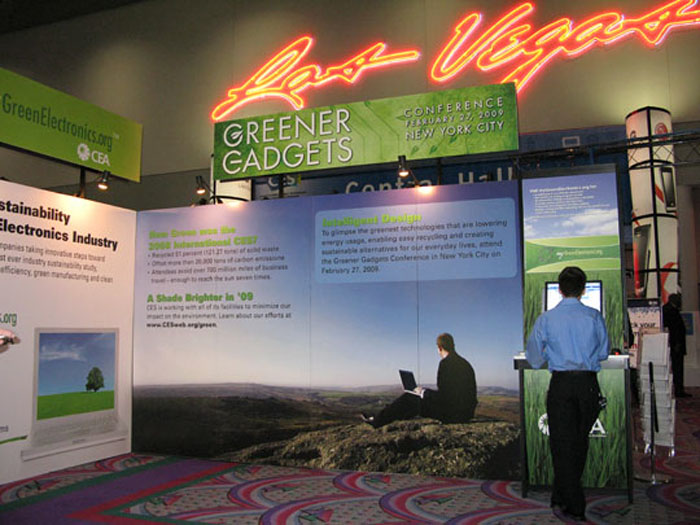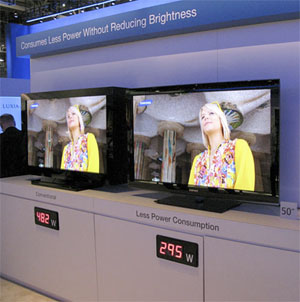
The electronics industry is increasingly using “green” technology as a selling point, as seen at the CES. Joshua Brockman/NPR.
January 9, 2009
By JOSHUA BROCKMAN
Walking the floor of the International Consumer Electronics Show in Las Vegas, one passes a dizzying array of televisions, computers and cameras that are all lit to perfection and powered up to showcase their features.
It’s a glitzy display — especially when you stop to gaze at the stepped array of big-screen televisions that look like they’re populating a mountainside. Looking up at one such display at the Sharp booth, Noah Horowitz, a senior scientist for the Natural Resources Defense Council, says: “I used to call this the wall of shame. Now, it’s getting closer to the wall of fame.”
The reason for this transformation? The electronics industry has been taking significant steps to improve the energy efficiency of televisions.
“Consumer electronics is the fastest-growing source of electricity use in people’s homes,” Horowitz says. “It’s now up to 15 or 20 percent.”
That’s up from less than 5 percent more than a decade ago. This increase is of concern to scientists and environmental advocates like Horowitz because, he says, electricity generated by power plants remains the biggest source of global-warming pollution.
Monitoring Electricity Usage
Just five years ago, Horowitz says, no one knew how much electricity a big television used. But this year, things are different. Clearly on display — as this reporter walked with Horowitz on a tour of the show, past hundreds of televisions manufactured by Sharp, Samsung and Panasonic — were side-by-side comparisons showing the number of watts new televisions draw compared with previous years’ models. The latest versions show up to a 50 percent reduction in electricity usage.
While that’s a good sign the industry is working to cut energy consumption, Horowitz says he remains concerned because televisions continue to get bigger and they’re increasingly on for more hours per day. What’s more, high-definition signals require more information and therefore more power.
Thin Is In
Many televisions unveiled this year have screens that appear as thin as a pad of paper. The upside to the slim design is that it requires less material and it also means that more units can be shipped together in a crate or container.
But many of these, which utilize LED backlights instead of the traditional LCD television displays, are designed for the high-end consumer market and have high price tags. That’s the case for Sharp’s 46-, 52- and 65-inch Limited Edition XS1 televisions, which are expected to sell for $8,000 to $15,000.
Talking Green
This year’s CES has been breaking new ground when it comes to green talk. Senior electronics industry executives have gathered to discuss everything from what it means to label a product as “green” to sharing best practices for recycling electronics.
The Consumer Electronics Association, which puts on the conference, commissioned an outside company, Technology Forecasters Inc., to compile the industry’s first sustainability report in November.
“We haven’t reached our destination in terms of sustainability,” says Parker Brugge, the CEA’s vice president of environmental affairs and industry sustainability.

Samsung touts televisions using less power in a side-by-side comparison at the International Consumer Electronics Show in Las Vegas. Joshua Brockman/NPR.
That hasn’t stopped executives from making bold claims. At a press event Wednesday, Sony Chief Operating Officer Stan Glasgow said it was the company’s goal “to recycle 1 pound of waste for every pound of product.”
And executives from Panasonic, Sharp and Toshiba also said they would join a recycling network established by the Electronic Manufacturers Recycling Management Co. Consumers would be allowed to drop off their televisions and consumer electronics free of charge for recycling at 280 locations across the country — with at least one in every state. (The program only applies to devices made by these brands.)
John Frey, the senior sustainability executive for Hewlett-Packard, says HP and other companies realize it’s not just a question of offering free recycling to consumers: “It’s one thing to take it back. It’s another thing to make sure waste is not inappropriately handled.”
Colors And Catchphrases
The slogans and catchphrases painted on the walls of some manufacturers’ booths — as well as the soothing earth-tone paint colors — reflect the industry’s green marketing intentions. LG’s catchphrase for its environmental area this year is “life’s good when it’s green.” Panasonic has its “Eco Idea” strategy.
“I think that consumers have a little bit of skepticism about these claims,” says Michael Gartenberg, vice president for mobile devices for Jupitermedia. “Consumers are looking at products that are perceived to be environmental and eco-friendly.” A case in point, he says, is Apple’s campaign for the new MacBook, which is being marketed for its green qualities.
“It’s probably not a primary purchase driver, but it becomes one of those things that can affect the tipping point,” Gartenberg says.
Cell phone companies are also marketing green products. Motorola released the Renew, its first phone with an outer shell made of recycled plastic bottles. And Motorola promises to offset the phone’s carbon footprint by investing in renewable energy.
Walking The Green Path
“You just can’t put ‘green’ on there without some claim,” says Bob Scaglione, senior vice president of marketing for Sharp. “You have to back it up with data.” He notes that Sharp’s 2009 line of televisions has a label touting a 20 percent reduction in power use.
Still, consumers still face a sea of information that isn’t so easy to navigate.
“From a consumer’s perspective, it’s very difficult to know the difference between a product that is painted green versus one that is truly greener,” says Jeff Omelchuck, the Green Electronics Council’s director.
Horowitz, of the Natural Resources Defense Council, walks into Samsung’s booth, which features a wall of sleek TVs. These are LCD televisions, but the primary light source is LEDs instead of cold cathode fluorescent lamps. A saleswoman repeats a mantra for visitors, explaining that these sets are “environmentally friendly” because they use 40 percent less power.
At another Samsung display there’s a comparison of two plasma televisions, which are more energy intensive than LCD displays. Both plasmas are 50-inch sets, but one uses almost 200 watts less. Above the display, a sign says: “Consumes less power without reducing brightness.”
Horowitz says the industry’s old way of thinking was that you’d have to give something up to be energy efficient.
“Many of these companies are really stepping up to the plate now,” he says. “It’s not just talk.”
Green Resources
© NPR
